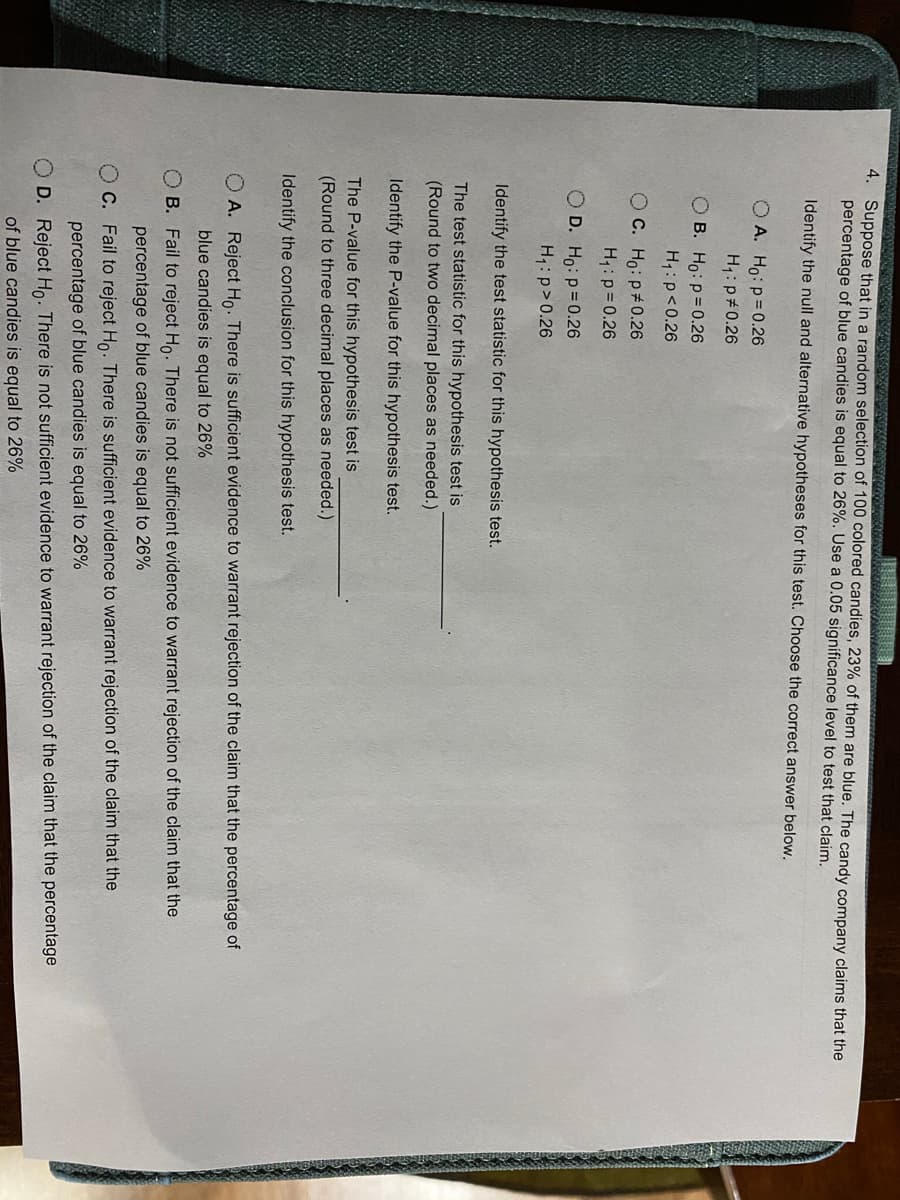4. Suppose that in a random selection of 100 colored candies, 23% of them are blue. The candy company claims that the percentage of blue candies is equal to 26%. Use a 0.05 significance level to test that claim. Identify the null and alternative hypotheses for this test. Choose the correct answer below. O A. Ho: p= 0.26 H: p#0.26 O B. Ho: p= 0.26 H:p<0.26 O C. Ho: p#0.26 H:p=0.26 O D. Ho: p=0.26 H: p>0.26 Identify the test statistic for this hypothesis test. The test statistic for this hypothesis test is (Round to two decimal places as needed.) Identify the P-value for this hypothesis test. The P-value for this hypothesis test is (Round to three decimal places as needed.) Identify the conclusion for this hypothesis test. O A. Reject Ho. There is sufficient evidence to warrant rejection of the claim that the percentage of blue candies is equal to 26% O B. Fail to reject Ho. There is not sufficient evidence to warrant rejection of the claim that the percentage of blue candies is equal to 26% O C. Fail to reject Ho. There is sufficient evidence to warrant rejection of the claim that the percentage of blue candies is equal to 26% D. Reject Ho. There is not sufficient evidence to warrant rejection of the claim that the percentage
4. Suppose that in a random selection of 100 colored candies, 23% of them are blue. The candy company claims that the percentage of blue candies is equal to 26%. Use a 0.05 significance level to test that claim. Identify the null and alternative hypotheses for this test. Choose the correct answer below. O A. Ho: p= 0.26 H: p#0.26 O B. Ho: p= 0.26 H:p<0.26 O C. Ho: p#0.26 H:p=0.26 O D. Ho: p=0.26 H: p>0.26 Identify the test statistic for this hypothesis test. The test statistic for this hypothesis test is (Round to two decimal places as needed.) Identify the P-value for this hypothesis test. The P-value for this hypothesis test is (Round to three decimal places as needed.) Identify the conclusion for this hypothesis test. O A. Reject Ho. There is sufficient evidence to warrant rejection of the claim that the percentage of blue candies is equal to 26% O B. Fail to reject Ho. There is not sufficient evidence to warrant rejection of the claim that the percentage of blue candies is equal to 26% O C. Fail to reject Ho. There is sufficient evidence to warrant rejection of the claim that the percentage of blue candies is equal to 26% D. Reject Ho. There is not sufficient evidence to warrant rejection of the claim that the percentage
College Algebra (MindTap Course List)
12th Edition
ISBN:9781305652231
Author:R. David Gustafson, Jeff Hughes
Publisher:R. David Gustafson, Jeff Hughes
Chapter8: Sequences, Series, And Probability
Section8.7: Probability
Problem 58E: What is meant by the sample space of an experiment?
Related questions
Question

Transcribed Image Text:4. Suppose that in a random selection of 100 colored candies, 23% of them are blue. The candy company claims that the
percentage of blue candies is equal to 26%. Use a 0.05 significance level to test that claim.
Identify the null and alternative hypotheses for this test. Choose the correct answer below.
O A. Ho: p=0.26
H1: p#0.26
O B. Ho: p= 0.26
H1:p<0.26
O C. Ho: p#0.26
H: p= 0.26
O D. Ho: p=0.26
H: p>0.26
Identify the test statistic for this hypothesis test.
The test statistic for this hypothesis test is
(Round to two decimal places as needed.)
Identify the P-value for this hypothesis test.
The P-value for this hypothesis test is
(Round to three decimal places as needed.)
Identify the conclusion for this hypothesis test.
O A. Reject Ho. There is sufficient evidence to warrant rejection of the claim that the percentage of
blue candies is equal to 26%
O B. Fail to reject Ho. There is not sufficient evidence to warrant rejection of the claim that the
percentage of blue candies is equal to 26%
O C. Fail to reject Ho. There is sufficient evidence to warrant rejection of the claim that the
percentage of blue candies is equal to 26%
O D. Reject Ho. There is not sufficient evidence to warrant rejection of the claim that the percentage
of blue candies is equal to 26%
Expert Solution
This question has been solved!
Explore an expertly crafted, step-by-step solution for a thorough understanding of key concepts.
This is a popular solution!
Trending now
This is a popular solution!
Step by step
Solved in 2 steps

Knowledge Booster
Learn more about
Need a deep-dive on the concept behind this application? Look no further. Learn more about this topic, statistics and related others by exploring similar questions and additional content below.Recommended textbooks for you

College Algebra (MindTap Course List)
Algebra
ISBN:
9781305652231
Author:
R. David Gustafson, Jeff Hughes
Publisher:
Cengage Learning

College Algebra (MindTap Course List)
Algebra
ISBN:
9781305652231
Author:
R. David Gustafson, Jeff Hughes
Publisher:
Cengage Learning